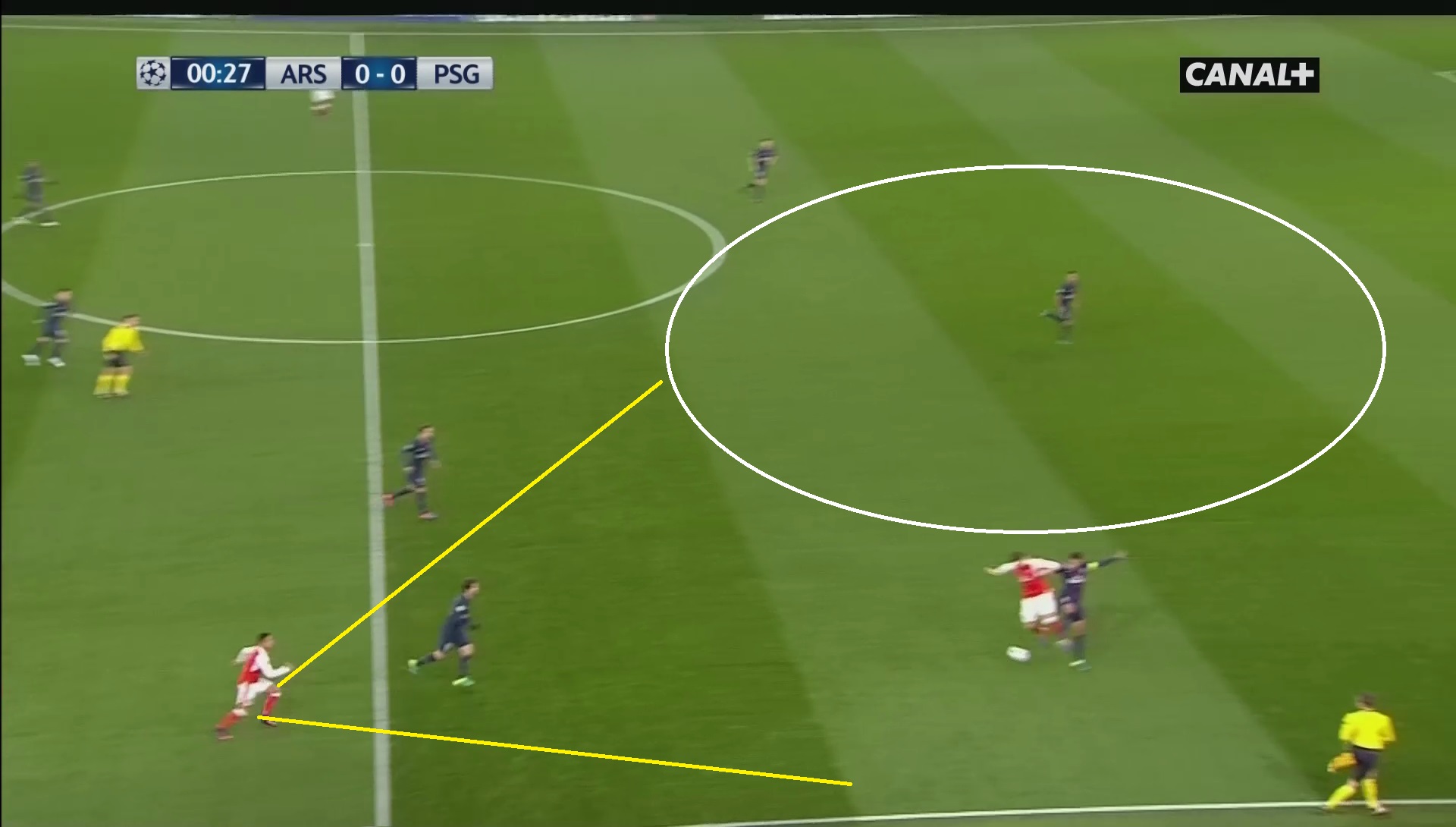Eric Devin writes a detailed tactical analysis about the UEFA Champions League match that ended Arsenal 2-2 PSG.
Despite being a thrilling encounter in terms of its result and implications, the lesson learned from Paris Saint-Germain’s trip to Arsenal should ultimately be one of two limited teams doing battle in a way that did little to inspire confidence. The Gunners were sloppy in possession, unadventurous and limited in wide areas. Paris Saint-Germain, as they have since the departure of Zlatan Ibrahimovic, lacked a reliable focal point in attack, with Edinson Cavani getting only one of eight shots on target. They somewhat surprisingly controlled possession, but with Blaise Matuidi, the nominal left winger, playing in a deeper role than the teamsheet would suggest, there was little venom from the French side.

Made using TacticalPad
Arsenal (4-2-3-1): David Ospina; Carl Jenkinson (Alex Oxlade-Chamberlain 81′), Shkodran Mustafi, Laurent Koscielny, Kieran Gibbs; Aaron Ramsey, Francis Coquelin (Theo Walcott 80′); Alexis Sanchez, Mesut Ozil, Alex Iwobi (Granit Xhaka 77′); Olivier Giroud
Paris Saint-Germain (4-3-3): Alphonse Areola; Thomas Meunier, Marquinhos, Thiago Silva, Maxwell; Marco Verratti, Grzegorz Krychowiak (Hatem Ben Arfa 67′), Thiago Motta; Lucas Moura (Jesé Rodrgiguez 89′), Edinson Cavani, Blaise Matuidi
In a match which could potentially alter each side’s season, it was disappointing to see so many wasted opportunities, not only from Cavani, but from two experienced managers. Injuries certainly played a role, as each side were missing key personnel. Would Paris Saint-Germain have had a more comprehensive team, with more danger in attack with their first choice fullbacks, Adrien Rabiot and Angel Di Maria available? Undoubtedly. On the other side of the ball, would a healthy Hector Bellerin have provided Arsenal with the threat and width to pressure an aging Maxwell? Would Granit Xhaka have provided more thrust from central midfield, in place of a half-fit Aaron Ramsey or a limited Francis Coquelin? Equally so; thus, we were left with a match lacking in class, but not in tactical intrigue.


The two images above show PSG’s defense being torn apart early in the match, when they struggled to settle. Arsenal failed to take advantage of the visitors at this point, and eventually lived to regret it. In the left image, Carl Jenkinson (with ball) turns to move upfield, (white arrow) and PSG’s midfield is all over the place. Nominal defensive midfielder Krychowiak (yellow circle) has moved wide to mark Ozil (on ground) but has left the space behind him wide open as Motta and Verratti are caught flat-footed. Sanchez provides the easy option for a pass, his potential paths, cutting inside or moving wide, indicated by the white lines, with Maxwell behind him to anticipate his run.
Under pressure from Matuidi, though, the Arsenal right back instead opted to loft a ball to Giroud, as we see in the second image. The Frenchman is many things, but pacy he is not, and despite being in space, Silva is able to move over to deal with him, extinguishing the hosts’ threat. Putting a striker in a one-on-one situation may seem like a success, but if Giroud had been able to hold the ball up and lay it off for Sanchez, the Chilean could have either cut inside into acres of space (white circle around Marquinhos) or gone past him on the wing, to hit a return ball or look for Iwobi from the opposite flank. Sanchez had started up front in the previous encounter, and Giroud was only a substitute as he worked his way back to fitness from the summer, and some had lamented a lack of a physical presence to bully PSG’s center backs, but on this occasion, the pace and positional flexibility of Walcott or Oxlaide-Chamberlain would have been much more suitable in terms of stretching the French side on the flanks.

via whoscored.com
Here, we see PSG’s players in their average position for the match, and the striking realization the formation more closely resembles a 3-5-2 than a 4-3-3, with the two fullbacks pushed very high and Kyrchowiak sitting deep. Matuidi (14) takes his place in midfield, which does deny the team width in attack but also allows him to play in a role more akin to his habitual spot in central midfield, with Lucas operating as more of a central playmaker than an orthodox winger. Besides adding defensive solidity, this also allowed the Brazilian to flourish in a free role, popping up on both wings and stretching play without having to track back as much.
The high position of the fullbacks is typical for PSG, but typical for Layvin Kurzawa and Serge Aurier isn’t necessarily the same for Maxwell and Meunier. Both are able deputies, but their lack of directness and pace should have seen Arsenal pressing high up the pitch, forcing the center backs to play the ball while at the same time trying to get space in behind in wide areas.


via squawka.com
The image above at left shows that lack of pressure to a tee; Krychowiak has dropped deep and has the ball at his feet, ready to play a long pass. Rather than harrying the ball, Giroud is barely in the picture (orange circle at bottom right). Krychowiak thus has multiple options, being able to shift play to one of the two center backs, hit a ball into the flat for Meunier to chase (yellow line) or play a shorter pass for Verratti. Thus, while the Pole is decent at playing this type of ball, he is not to the level of Silva or Marquinhos, nor is he as adept with the ball at his feet or as quick, and should have been seen as the weak link in PSG’s defense.
With him playing such a deep role, PSG were ripe to be pressed, but the two defenders and Krychowiak (and Motta when he dropped deeper after the introduction of Ben Arfa) were afforded an incredible amount of time on the ball. Iwobi is also deeper, with Ozil and Sanchez forming a de facto 4-4-2, but none of the front four pressing the ball, a simply incredible problem in a 4-2-3-1, a system which affords an extra attacker. Including Verratti, PSG’s midfielders completed nearly 70% of their long passes, giving their slow-footed fullbacks that much more time to not only get forward to aid the seemingly isolated Cavani, but also to nullify any potential negative impact the passing of Krychowiak could have. The right image shows the long passes completed by the two center backs and the midfielders excluding Matuidi, with more success on the right owing to Meunier being slightly quicker than Maxwell and Matuidi’s more withdrawn position.


In addition to failing to put pressure on the visitors, Arsenal also failed to reciprocally stretch play into wide areas consistently. With PSG having more possession and the fullbacks easily caught out, as discussed earlier, an approach which saw Iwobi and Sanchez act more as orthodox wingers than inverted ones would have undoubtedly been more successful, especially on the counter. Instead, the situation at left became all too typical. Here, Coquelin (in red circle) has won the ball and is seeking to drive upfield, but Arsenal’s compactness, illustrated by the orange and white boxes, is their undoing. Coquelin actually does manage to pick a pass to Iwobi in this sequence, even as Verratti anticipates it (yellow line).
However, the young Nigerian, rather than trying to bring play wide to simultaneously retain possession and allow his fellow attackers more space, drives ahead, as the second image shows. Verratti struggles to join the play, but Meunier (top of diamond), with Gibbs nowhere to be seen, is able to come inside and provide pressure enough to give the Italian time to catch up with the play. Likewise Maxwell (bottom of diamond), on a right side of midfield that is similarly bereft of red shirts. With Krychowiak in a free role, and Matuidi hurrying to continue to apply pressure and Sanchez behind the play, the result is inevitable as Arsenal lose the ball.
Even with Matuidi dropping deep to aid the slower Motta, (left point of diamond) this was simply too easy for PSG, Iwobi, Sanchez and Ramsey (who admittedly gave a good effort but is still lacking fitness) readily ceding possession, which only served to make things more readily absorbed by a slow/aging midfield. Xhaka would have likely served as a better partner for either Coquelin or Ramsey, as he is more fleet of foot and has a much better range of long passing than either of the two who did start.
Conclusion
Hindsight, though, is 20-20, and the tactical missteps by both managers probably meant that this match, with only one goal scored from open play, was deserving of its outcome. Paris Saint-Germain had made a few errors, but Emery’s use of Matuidi to affect a 5-4-1 / 4-4-2 hybrid gave the visitors just a bit more solidity in midfield, while Wenger’s failure to attack PSG’s second string fullbacks left his team starved (by their standards) of possession. Both teams are assured of progression, and all of Bellerin, Kurzawa, Aurier and Rabiot will be back by the time of the knockout stages, adding an extra dimension to both sides’ play. However, even the round of 16 can kick up a formidable opponent, and if Wenger and Emery don’t take a more holistic approach to their tactics, their European adventures could be over before they’ve begun.
Read all our Tactical Analyses here.
























































